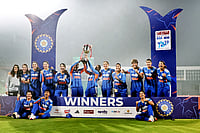Why More Women Are Taking To Drink
Economic independence, changed social environment have helped break down middle-class taboos against women drinking
Work pressures, professional responsibilities, peer pressure, make many women drink several times a week
A plethora of bars in metro cities with weekly ‘Ladies’ Nights’, easy availability of a wide range of drinks also fuel the drink habit
Women drinkers account for a quarter of the Indian alcohol industry’s annual 15 per cent growth
The majority of women drinkers drink more than the ‘safe alcohol limit’ every week
Alcohol has a more toxic effect on women than on men. Women are also more prone to alcohol addiction.
***
"I
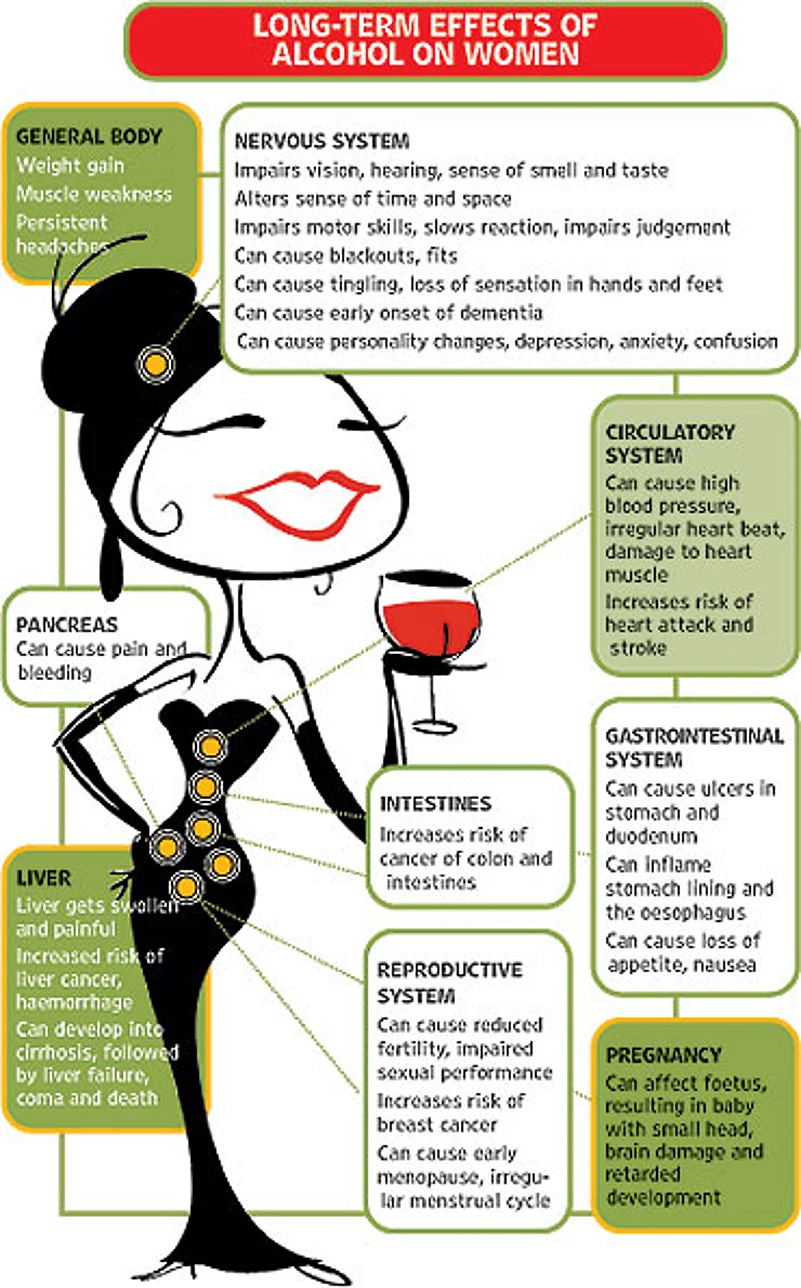
Harsimran is one of thousands of urban, middle-class Indian women who head to a bar a couple of times every week, to wind down with a drink after a hard day’s work, or pass the night in a hedonistic blur of potent cocktails and shots. Fuelled with their new financial independence and the increasing social tolerance of women’s drinking, more urban women are drinking than before. They might begin their drinking careers with innocuous-tasting Baileys and breezers; comforting and sweet confections which, nevertheless, contain hard spirits. But they soon move on to undisguised and unabashedly stiffer drinks—whisky, vodka, gin.
A number of studies, including the recently released Alcohol Atlas, are also throwing up some explosive data on the drinking patterns of Indian women. For one, never mind all those debates on whether the legal drinking age ought to be 25 or 21, many girls now start drinking in their teens. Like 19-year-old Leela. "I’ve been drinking since I was 12," says the trainee in a Chennai-based ad agency. "And by the time I was 15, I’d done all that 18-year-old kids do. So when my college classmates got excited about their first beer, for me, it was all pretty sedate."
What’s more, more than half the number of women who drink are "binge-drinking"—putting the drinks away as fast and furiously as their male counterparts. At most parties, when everybody agrees that one’s level of merriment is measured in direct proportion with the number of drinks they’ve downed, binge-drinking becomes almost a social obligation. It’s a daunting challenge to persistently sidestep your hosts’ outraged cries of "Where’s your drink?" Neither does it win you any admirers. Neeti, 23, a researcher and frequent pubcrawler from Chennai, reserves her most scathing contempt for teetotallers. "Why would you come to a pub and then not drink ? That’s boring!" she declares. "You risk being labelled a moralistic tightass, unable to relax. At such parties and get-togethers, sober people don’t fit in."
The glass is also less full for the sober when a companionable drink together makes or breaks successful professional relationships. With colleagues, contacts, or crucially, your boss. "Before I started my job in advertising, drinking was a weekend thing and a birthday thing," observes Divya Joseph, known to her friends as DJ. "But since I started work, it’s become habitual. It’s become a meeting thing, to catch up with old friends; and at work, sometimes an everyday thing—something the bosses do to chill, to celebrate a successful pitch with your colleagues, or to ease tension and frustration on late nights, when we’re working till 2 am." The consequence? "I certainly don’t drink only two nights a week."
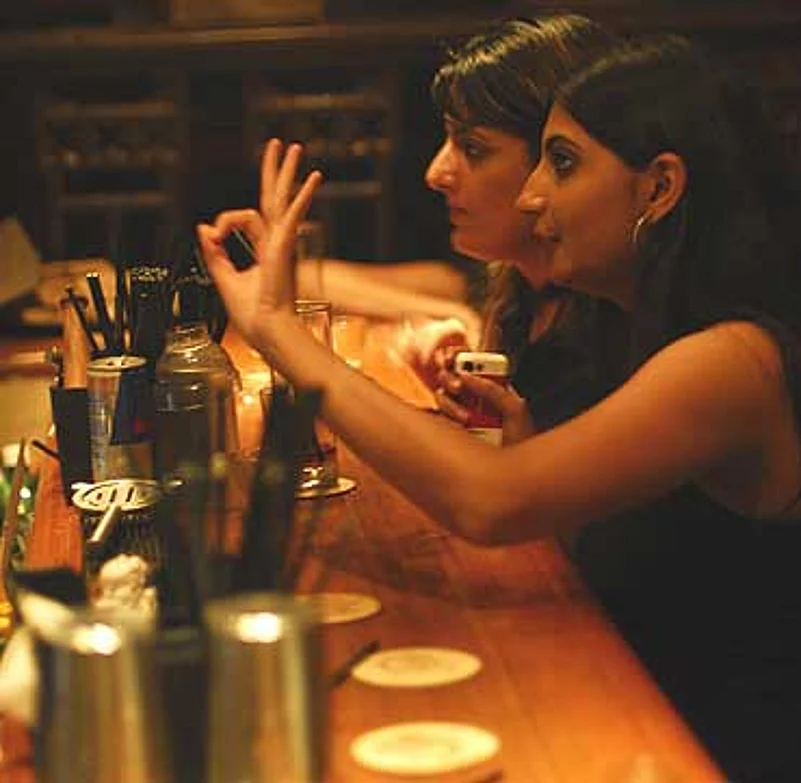
How many fingers? At the Bootleggers Pub in Mumbai
That, in turn, is leading to even graver consequences, as Dr Atul Kakkar, general physician, has witnessed. "I’ve been practising for the past 17 years, but it’s only in the past five years that I’ve been getting young girls in for ailments directly related to drinking: oesophagitis, gastritis, hepatitis, lack of concentration, memory problems, and minor traumas and accidents. I get nearly five female patients per month complaining of these things."
Dr Kakkar recalls one incident in particular which struck uncomfortably closer home: "Two years back, a 19-year-old girl who’d passed out of the same school that I had came to me with a liver problem. When her parents left the room, she confessed that she’d been drinking heavily for the past few months, since she’d begun work at a call centre. That shook me; I found it difficult to believe that she was a product of the same background, the same environment, as me."

The last laugh: Serious about drinking at the Agni Bar in Delhi
But it isn’t the same environment any more, not by any stretch of the imagination. It’s a world where the spectacle of a tipsy woman tottering on high heels isn’t confined to a Bollywood allegory of fallen virtue, but a sight so common now that it no longer raises an eyebrow. Where girls nursing pounding hangovers outdo one another with tales of how cataclysmically "wasted" they got the previous night. Where the mid-week ‘Ladies’ Night’ orgy of free cocktails has become de rigueur in any watering hole aspiring to become the next it-bar.
And, with a quarter of the Indian alcohol industry’s 15 per cent annual market growth being fuelled by women, liquor companies are constantly diversifying their arsenal to make sure women don’t stray far from the bar. Advertising their wares might be banned, but this doesn’t stop them from sponsoring exactly the sorts of events that attract hip young women—rock concerts, club nights, parties—to sample newly launched liqueurs, breezers and pre-packaged shots.
How Much Is Safe For Women?
Drinking more than 10-14 units of alcohol per week can seriously damage a woman’s health. (In contrast, the safe limit for men is up to 21 units per week). Ideally, women should give a gap of a couple of days between drinking sessions. Here’s how to tally up the costs that your bar tab didn’t mention! By this reckoning, about 7-8 glasses of wine a week, spread over 3 drinking sessions, is safe for women.
Mug of beer—1.3 units
Glass of white/red wine— 1.6 units
Glass of champagne—1.5 units
Single whisky—1 unit
Single white rum—0.9 units
Glass of Baileys liqueur—0.9 units
Breezer bottle—1.4 units
Tequila shot—1.9 units
For the increasing number of women with the social sanction and disposable incomes to have access to this beguiling array of booze, it’s hard to stop at just one or two. And, as a recent NIMHANS study on normative drinking patterns amongst Indian women has found, more than half do not stop at one or two. Instead, in a single session, the majority down twice as much as the "safe" recommended dose of alcohol (given above)—for whisky-drinkers, that’s a paltry two drinks.
Sadly enough, though practice might enable the ladies to quaff the hard stuff just as swiftly as their male drinking buddies without toppling to the floor, their livers don’t fare quite as well. Women’s livers contain smaller, more sluggish-acting amounts of alcohol dehydrogenase (ADH), the enzyme that breaks down alcohol. To make matters worse, the toxic effect of alcohol on the system is intensified because women’s bodies contain less body water (resulting in more concentrated blood alcohol levels), more body fat, and sex hormones.
The longer-term impacts are frightening: tissue, brain and liver damage. "One thing is beyond debate," says Dr Vivek Benegal, the deaddiction specialist behind the NIMHANS study. "And that’s something women need to be aware about. They run a higher risk of developing alcohol-related problems with smaller doses of alcohol, and in a shorter drinking career."
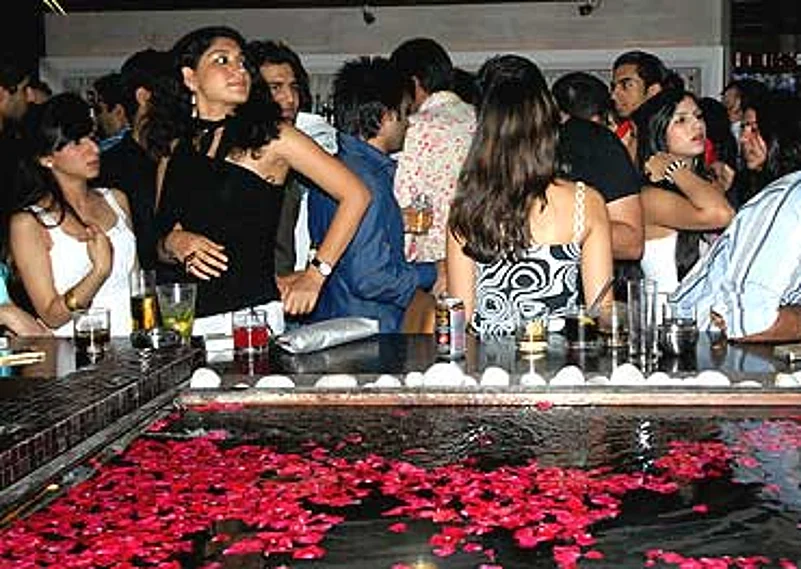
Cheers: There are as many women as men at the Tabula Rasa in Delhi
Unlike Harsimran, with her drink-fuelled dance-a-thons, most women tend to drink for more than merely hedonistic reasons, says Dr Benegal. "The large swathe of women who drink do so to relieve a negative mood state—sadness, anxiety or dysphoria—unlike men, who by and large drink to feel good, and for social intercourse," he says. So, though there is no precise link between moderate social drinking and alcoholism, women who drink habitually do stand a higher chance of developing an addiction than do men.
As the NIMHANS study shows, while the number of rural and urban poor women drinking has remained more or less the same, the drinking pool has in recent years been swelled by affluent women, with their own jobs and their own sets of wheels. "They may start off drinking with a more convivial motive, to be with friends, which falls in line with the Western pattern," concedes Dr Benegal. "But the danger is that as they continue, they might tend to fall back on the Indian pattern—drinking compulsively, to get drunk."
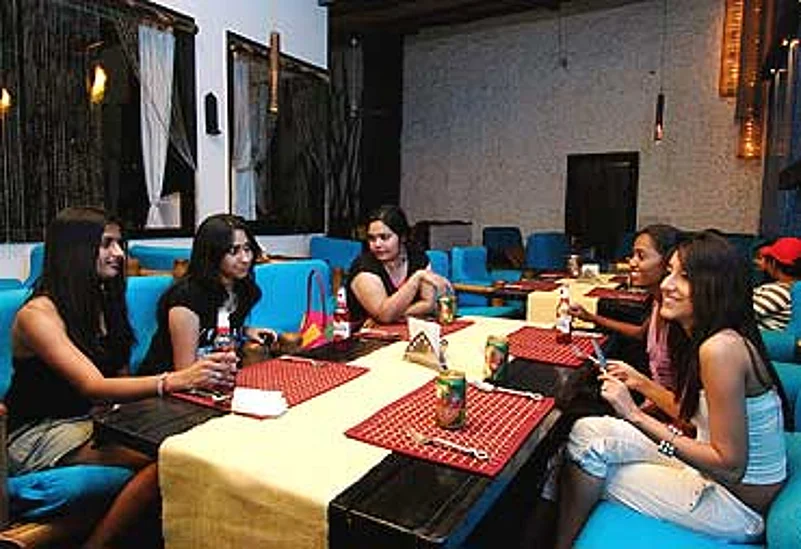
Bangalore isn't immune to the trend either, NYK Restobar
According to Raman (name changed), an ex-chairman of the New Delhi chapter of Alcoholics Anonymous (AA), this has already begun to happen. When he joined the support group 11 years ago, he hardly met any women. Now, he says, there are about 15 regular members, as well as dozens that try to join, but find they’re not quite ready to quit their trysts with the tipple. "Alcoholism is like a mine lying in a field," Raman muses. "Unless you step on it, it won’t go off. Earlier, everyone stayed home, but today everybody gets on the field. In my time, it was easier to get a foreign female than to get foreign whisky. Both were needed! Today you get foreign beer, wine, whisky, vodka," he pauses, as if to savour an imaginary swig of each. "And if you pass them up, you’re told ‘You’re not drinking? Are you a stick-in-the-mud?’ That’s how a potential alcoholic gets hooked."
Precisely how Nupur (name changed) embarked on 11 long, unremittingly miserable years battling an alcohol addiction. The product of a sheltered upbringing, she considered alcohol "sick". But the first gin-and-lime cordial she had at a party had her singing a different tune altogether. "When I said I didn’t want a drink, the host said he’d make me a really nice one," recalls Nupur. "And it was! It was fresh, sweet, heady, and I couldn’t taste the alcohol. It put me in a happy mood, and made it a very gay evening."

On a high: Drinking and dancing at Elevate in Noida
After returning from a pitched 10-day drinking binge in Jaipur with her husband, though, she found it impossible to cut back on the five-gin libation she’d become accustomed to. "My body began craving for it!" exclaims Nupur. "I drank vodka in the afternoon, because I thought it didn’t smell, and at night, I drank five or six whiskies. And after a while, the days became a blur. It didn’t matter what I was drinking, I just needed to drink constantly, to get that hit." Her marriage, which was never good to begin with, fell apart completely. "At parties, I was belligerent, and I made a fool of myself with men. I ended up feeling whorish and ashamed of myself!"
A former college beauty queen, Nupur’s face got bloated and her hair stringy. Old friends she ran into didn’t recognise her, and when they saw what had become of her, promptly steered clear of her. When she was bedridden with a back problem and began drinking round the clock, she finally hit rock-bottom. "I could no longer eat, I was sick all the time, and one day, I started throwing up water." The dreaded trip to the doctor followed. "He told me I was alcoholic! I didn’t believe him! Alcoholic, me? That was the guy on the road, with torn clothes, who’d fallen into the gutter!"

Beer hug: Young women are regulars at Rouge Bar, Mumbai
Joining AA ironed out that misconception. And has helped her stick to the straight-and-narrow for the past 11 years. Nupur is a regular, immaculately coiffed and made-up presence in their weekly ladies’ meetings behind a quiet church in Delhi. Here, her tightly-knit circle of fellow recovering alcoholics celebrate their sobriety over cupcakes and chicken puffs, and share tales of loss, death and the stark depths of loneliness; interspersed with frequent gossipy asides about recalcitrant cooks and husbands.
Over the past few years, the ladies have noticed a large influx of young twentysomething girls, who’ve stepped up the one-new-member a year norm to more than a dozen. "But they’re more like visiting faculty!" laughs Nupur. "The young ones never stay. They say, ‘You enjoyed alcohol for so many years, and came in after so long, so why do you want to stop us from having our share of fun?’" However, having learnt it the hard way, Nupur adds ruefully, "Alcoholism is no fun! It’s an ugly, self-destructive thing." As long as they don’t slide into that pass, the spirit can keep flowing.
























